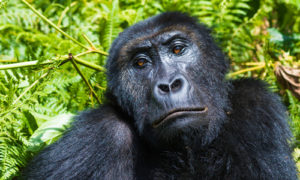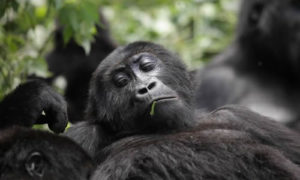Eastern Lowland Gorilla Trekking in Congo takes you to some of the remotest areas in Africa in search of the largest primate on earth. Gorillas are large forest dwelling apes that live in the forests, swamps and lowland areas of East, West and Central Africa. There are two species of gorillas – the western gorillas and eastern gorillas. Each specie is further divided into two. Western gorillas are divided into Cross River gorillas and Western lowland gorillas.
 The eastern gorillas are divided into two sub-species – the mountain gorilla and Eastern lowland gorillas found only in Kahuzi Biega National Park. Western lowland gorillas are more common (in zoos) and fairly distributed in regions of Equatorial Guinea, Gabon, Congo Brazzaville, Angola, Central African Republic and Cameroon and the Democratic Republic of Congo. Mountain Gorillas can only be found in Uganda, Rwanda and the Democratic Republic of Congo. The Odzala National Park in Congo Brazzaville hosts the largest known population and density of western lowland gorillas. Because most of them live in extremely remote habitats, researchers find it hard to estimate their exact population. It was first thought that about 100,000 western lowland gorillas were still living in the wild based on estimations done in the 1980’s. However a recent discovery of an estimated 125,000 individuals in a remote swampy are in the north of Congo Brazzaville has excited both researches and conservationist alike.
The eastern gorillas are divided into two sub-species – the mountain gorilla and Eastern lowland gorillas found only in Kahuzi Biega National Park. Western lowland gorillas are more common (in zoos) and fairly distributed in regions of Equatorial Guinea, Gabon, Congo Brazzaville, Angola, Central African Republic and Cameroon and the Democratic Republic of Congo. Mountain Gorillas can only be found in Uganda, Rwanda and the Democratic Republic of Congo. The Odzala National Park in Congo Brazzaville hosts the largest known population and density of western lowland gorillas. Because most of them live in extremely remote habitats, researchers find it hard to estimate their exact population. It was first thought that about 100,000 western lowland gorillas were still living in the wild based on estimations done in the 1980’s. However a recent discovery of an estimated 125,000 individuals in a remote swampy are in the north of Congo Brazzaville has excited both researches and conservationist alike.
Like mountain gorillas, Eastern lowland gorillas are peaceful and quiet apes – They can bark, roar or scream when the need arises. Gorillas never attack or become aggressive without provocation. The males may fight over females once in a while but only occasionally. Gorillas communicate using a variety of sounds or body language. They spend their day grooming, climbing, swinging on tree tops and playfully chasing each other. Their diet consists of leaves, stems, fruit and shrubs. Mountain gorilla groups generally contain more individuals than Eastern lowland groups – between 20 to 30 individuals or more. Both subspecies live in groups that are lead by a dominant silverback. The other males in the group can choose to live as bachelor in the group before hopefully taking over from the dominant silverback or leave to find mates. Females usually move on to join a lone male or another group of their preference once they reach age. Females are known for changing groups throughout their life. Because of their considerable size and weight, gorillas live mostly on the ground. Both species build nests on the ground to rest in the middle and end of each day using leaves, shrubs and tree branches. Juveniles and females may build their nests on top of trees.
 Eastern Lowland gorillas differ from mountain gorillas in many ways. They have browner coats and the silver on the back of the male may extend to the lower body to include the thighs. Although relatively small in size, the Eastern lowland gorilla has a larger and wider skull compared to the mountain gorilla. Eastern Lowland gorillas are more mobile than the mountain gorillas because their habitats spread over large areas. For both subspecies, the males are usually far larger than the females. Eastern Lowland Gorillas have remarkable intelligence and have been spotted using a variety of tools in the wild. Researchers have witnessed them testing the depth of swamps and rivers before deciding whether to cross to the other end. In captivity, Eastern lowland gorillas have shown remarkable ability to learn sign language. They may develop other habits and behavior that aren’t seen with those in the wild.
Eastern Lowland gorillas differ from mountain gorillas in many ways. They have browner coats and the silver on the back of the male may extend to the lower body to include the thighs. Although relatively small in size, the Eastern lowland gorilla has a larger and wider skull compared to the mountain gorilla. Eastern Lowland gorillas are more mobile than the mountain gorillas because their habitats spread over large areas. For both subspecies, the males are usually far larger than the females. Eastern Lowland Gorillas have remarkable intelligence and have been spotted using a variety of tools in the wild. Researchers have witnessed them testing the depth of swamps and rivers before deciding whether to cross to the other end. In captivity, Eastern lowland gorillas have shown remarkable ability to learn sign language. They may develop other habits and behavior that aren’t seen with those in the wild.
Eastern Lowland gorillas are considered critically endangered and are included in the International Union for Conservation of Nature (IUCN) List of species that need special protection. Because they live in regions that are often volatile, they are killed for meat or caught in fights between rebel groups. Their habitats are being destroyed by humans interested in mining, logging, expanding grazing lands, establishing farmlands and new settlements. Diseases such as Ebola have been found to wipe out entire families. However all is not lost for the lowland gorillas. Conservationists and researchers are working tirelessly to ensure their survival. World Wildlife Fund (WWF) is one organization that has taken lead in attracting funds and raising awareness about the need for closer monitoring and conservation of lowland gorillas.
Eastern Lowland gorilla Trekking in Kahuzi-Biega National Park
Despite the relatively high population of lowland gorillas remaining in the wild, it’s much easier to track the mountain gorillas. The range covered by lowland gorillas is wide requiring greater effort habituating them. The Central African Republic and Congo Brazzaville have the highest number of lowland gorillas and provide the greatest opportunities to see. However many of the strongholds of lowland gorillas in these two countries are found in very remote areas that are often volatile and with poor tourism infrastructure.
![]() The most convenient place to track lowland gorillas is in the Democratic Republic of Congo. DR Congo is a volatile country too but has become relatively peaceful in recent years as a result of having the largest UN peace keeping mission in the world. Visitors can track the Eastern lowland gorillas in either Kahuzi Biega National Park or the Western lowland gorillas at Maiko National Park. Kahuzi-Biega National Park is the only place where one can track Eastern lowland gorillas. About 400 Eastern lowland gorillas live in Kahuzi-Biega National Park in 9 groups. Three of the nine groups have been habituated and are open for tracking. The park is located in the eastern part of the Democratic Republic of Congo – near Bukavu and Lake Kivu. Named after Mount Kahuzi and Mount Biega, Kahuzi-Biega National Park is one of the largest game parks found in DR Congo. The terrain found in Kahuzi-Biega National Park provides perfect habitat for these great apes.
The most convenient place to track lowland gorillas is in the Democratic Republic of Congo. DR Congo is a volatile country too but has become relatively peaceful in recent years as a result of having the largest UN peace keeping mission in the world. Visitors can track the Eastern lowland gorillas in either Kahuzi Biega National Park or the Western lowland gorillas at Maiko National Park. Kahuzi-Biega National Park is the only place where one can track Eastern lowland gorillas. About 400 Eastern lowland gorillas live in Kahuzi-Biega National Park in 9 groups. Three of the nine groups have been habituated and are open for tracking. The park is located in the eastern part of the Democratic Republic of Congo – near Bukavu and Lake Kivu. Named after Mount Kahuzi and Mount Biega, Kahuzi-Biega National Park is one of the largest game parks found in DR Congo. The terrain found in Kahuzi-Biega National Park provides perfect habitat for these great apes.
How is Eastern lowland gorilla trekking in Kahuzi Biega?
In general, tracking lowland gorillas is only for those who have a very special interest in primates or wish to have a totally different experience from the usual – something truly special. The reward apart from seeing the gorillas is spotting areas that have never been visited by many before and marveling at the remarkable biodiversity.
 Tracking Eastern lowland gorillas in Kahuzi-Biega starts with briefing at the Tshivanga Visitor Centre which is found outside the park entrance. The park guide will peruse through the rule and regulations regarding lowland gorilla trekking while sharing with visitors’ facts the gorilla families and the terrain they live in. After the briefing, visitors are then led through established trails in search of the gorilla group. Eastern Lowland gorillas are always on the move and finding them may take an hour or two. Visitors will probably first spot the youngsters playing about before the dominant silverback appears to check if there is any potential threat to the family. If all is okay, he will allow trekker to watch the family. You are only allowed one hour with the gorilla group and this will be a perfect time to observe their behavior and take some great photos.
Tracking Eastern lowland gorillas in Kahuzi-Biega starts with briefing at the Tshivanga Visitor Centre which is found outside the park entrance. The park guide will peruse through the rule and regulations regarding lowland gorilla trekking while sharing with visitors’ facts the gorilla families and the terrain they live in. After the briefing, visitors are then led through established trails in search of the gorilla group. Eastern Lowland gorillas are always on the move and finding them may take an hour or two. Visitors will probably first spot the youngsters playing about before the dominant silverback appears to check if there is any potential threat to the family. If all is okay, he will allow trekker to watch the family. You are only allowed one hour with the gorilla group and this will be a perfect time to observe their behavior and take some great photos.
How does Eastern Lowland gorilla trekking compare to a mountain gorilla safari?
One thing to note is that mountain gorillas can only be tracked in Uganda and Rwanda and the The Democratic Republic of Congo. The overall population of mountain gorillas is about 1000. The Eastern lowland gorilla ( Gorilla beringei graueri) population has severely dwindled and less than 5000 remain on earth. It is the western lowland subspecies that make up for the high numbers mentioned. Mountain gorilla tracking in Uganda, Rwanda and DR Congo is more organized as the gorillas are found in relatively peaceful and accessible areas.
There are more habituated mountain gorilla families than lowland gorilla families. Uganda alone has 14 habituated mountain gorilla families which is more than all lowland habituated groups combined.
The success rate of finding eastern lowland gorillas is low compared to mountain gorillas. This is because lowland gorillas leave in vast areas requiring them to travel long distances looking for food. They move faster and keeping up with them is slightly more strenuous.
Tracking mountain gorillas is a more expensive venture. A mountain gorilla permit can cost up to $1500 in Rwanda. Eastern Lowland gorilla permits are more affordable at $400.
The rules and regulations to be followed while tracking both gorilla species are similar. Visitors are required to keep a distance of about 8 meters when watching lowland gorillas to prevent the transfer of human diseases that could cause the death of the entire family. The number of people allowed to track Eastern lowland gorillas groups is limited to 4 per session. In the case of mountain gorillas, 8 people are allowed in a day. It is designed that way to avoid stressing the gorilla family with a large unruly crowd and limit chances of disease spread.
For both gorilla trekking experiences, visitors need to come with the right clothing (rain jackets, long trousers) and sturdy shoes for walking through mud, forest and difficult terrain. A visitor would need to travel with drinking water, snacks and a camera.
Accommodation during a Lowland gorilla safari in Kahuzi Biega National Park
- Coco Lodge Bukavu: Is a mid-range lodge of 8 well furnished rooms with African theme decorations located near the park. They offer self contained rooms equipped with televisions, a restaurant, two lounges with a fireplace, a private bar and VIP lounge.
- L’Orchids Safari Club: Offer both budget and luxury. The starting price for some of the budget rooms is $90. Visitors are rewarded with beautiful scenery and wildlife animals moving besides Lake kivu. This hotel is considered among the best to book while on a Eastern lowland Gorilla trekking safari. Visitors can take part in other activities like bird watching, nature walks through the dense rain-forest, the park or tea plantations. There is even white water rafting in River Luhoho. Facilities in the Club include spacious rooms, well furnished bathrooms, a Lounge, restaurant services, helicopter hiring, a shopping center and swimming on on the Lakes beaches apart from the pool.
- Lake Side Hotel Bukavu: Is ranked a 4 star hotel and is located near the showers of Lake Kivu and Kahuzi Biega National Park. They have spacious resting bedrooms with en-suit bathrooms, a swimming pool, spa, a restaurant, well furnished dining rooms and a bar offering drinks/coffee.
- Hotel Begonias Bukavu: Located within Bukavu next to Kahuzi Biega National Park, this 4 star hotel is surrounded by a beautiful lush green courtyard. It has a large swimming pool that is perfect for relaxation after gorilla trekking. You will find well furnished, spacious and air conditioned rooms with a 24 hour front desk and room services. They even have balcony rooms offering great views, a children’s play ground, WiFi and a restaurant offering Chinese, African and American cuisine.
- Exodus Hotel Bukavu: This offers budget lodging facilities and is located within Bukavu. The hotel has committed multilingual staff who are determined to offer you the best services. The hotel has balconies with a sitting that has large flat screen TVs. There is a restaurant, a bar, Free WiFi and a Children’s play ground.
N.B: In case you are planning to track Eastern lowland gorillas at the Kahuzi Biega National park, try to plan your trip way in advance. The security situation in Congo is volatile and you need the guidance of a good tour company. If you choose to travel with Mission Africa Safaris, we will help you plan your entire tour by arranging for accommodation, transport, guidance and acquiring the permits.

